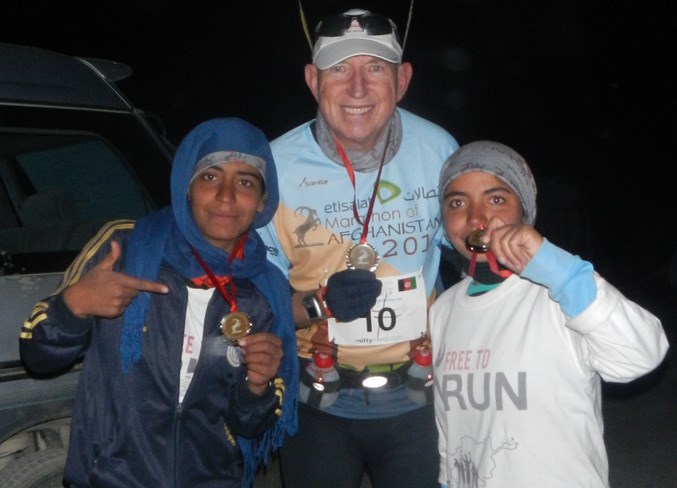Arriving in Bamyan, I knew there was a large number of Free to Run Afghan girls who would be running their first marathon and I wondered how I could help. Then it hit me, why not be the very first “pace bunny” in the Marathon of Afghanistan? I made a set of bunny ears and a time placard for seven hours, the cut off time being eight hours I knew that was going to be a challenging course. The maximum elevation is over 11,000 feet (3,360m) which means the oxygen level drops from 21 per cent to 13.7 cent. Also, it’s extremely hilly and the elevation gain/loss over the 42 km is 3,723 feet (1,135m). The next morning, I met up with Hassina, Free to Run Kabul field officer. She agreed to be my assistant pace bunny and introduced a group of six girls who would be running with us. They were all very excited. The first part of the race was a two-kilometres out and back and then we headed up on the first of many steep climbs out of the numerous valleys in Band e-Amir National Park. Things were going pretty well as we approached the first aid station. The route had been tough and one of the girls was complaining of back pain so I asked if she wanted to drop out but she said "no." The group kept moving forward and were on track up to the 10-km point. The course was marked with black arrows painted on wooden planks. At a fork in the road, we followed the arrow pointing left and continued for two km. Then we heard yells from across the valley and people were waving at us to come over. The girls and I trudged across some marshland and met up with the race volunteers. They told us that someone had turned the marker around and we were going the wrong way. I felt there was no way we would complete the marathon in seven hours. It would be tough enough for the girls and I to even make the eight-hour cut-off without this, as some of them were by now struggling with the terrain and physical issues. At the 14-km check point I asked the volunteers to pass along a request to the race director, to extend the cut-off to nine hours. We continued on and reached the 21km, half way check-point (23kms, due to the detour) in 4hrs 30mins. The first half had been a tough slog up and down the steep, dusty hills but we’d been told the second half would be easier. I then noticed the group had become smaller by one. I had lost sight of the girl with the bad back and another girl had started to lag. A key milestone on the route, at the 26 km point, is the arched entrance to the park. It was a long straight climb from there and, as I reached the top, I looked back and couldn’t believe my eyes. There, in the distance, was the girl with the bad back. It had been 20 km and 4 hours since I had last seen her and she had kept going. I decided there and then that I would try and get her, and the other girl who had fallen behind, across the line before the new, hoped-for nine-hour cut-off. At the 28 km check point I told Hassina I was going to wait there for the stragglers and that she was to take the rest of the group and carry on. Twenty mins later, the two girls caught up. One of them could speak a little English. She told me her name was Sonya, she was 14 years old and lived in Heart and the other girl, Anita, 16 years old is her sister. We had three hours to do 14 km. Every so often we would do a little run, maybe 100m just to keep some momentum going. We had an ambulance following us and I asked the girls on a number of occasions if they wanted to get in but they always said no. We had 55 mins to complete the last three kilometres. The girls were getting excited and wanted to get their medals. The sun was setting as we ran across the finish line with hugs and tears all round. The nine-hour cut off limit had been approved, so we had finished in 8 hours 46 minutes, with 14 minutes to spare. It had been an amazing day. In total, 20 Free to Run women and girls completed the marathon. The resilience, persistence and determination shown by these women and girls is an example to the rest of us.
© 2018 Martin Parnell
www.martinparnell.com




